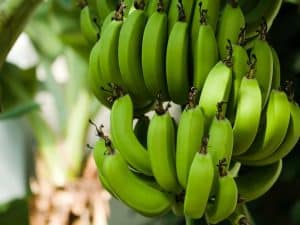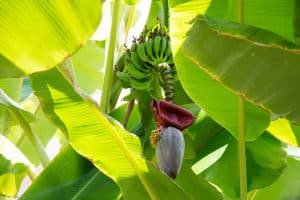When we think about a tropical holiday perhaps it’s the banana tree that holds the central arena of the dream. Well, either that or it’s the coconut tree. Or perhaps it’s more about the deep blue ocean teeming with tropical fish.
Well, no matter what it is that’s at the heart of your tropical holiday dreams, here’s something of an anomaly: banana trees aren’t actually trees. They are herbs. And they are the largest herbs in the world. But given the size, they are still considered, by most, to be a tree.
In plantations, once they’ve set fruit, banana ‘trees’ must be pruned back to ground level. In fact, many growers in Southeast Asia don’t prune them. They burn them. You get the same end result – fresh growth.
Even if you have a small yard, there is a banana ‘tree’ species that will fit.
The majority of banana species thrive in hot, tropical climates. But there are some cold-hardy bananas too.
If given enough water and light, bananas can perform well as houseplants.
Anyway, here are a few common questions answered in succinct fashion:
Can you grow bananas in Florida?
Yes.
Can you grow bananas in Texas?
Yes.
Can you grow bananas in California?
Yes.
Can bananas grow in the UK?
In the warmer areas of the UK there are some, though not many, hardy bananas that will crop outdoors. For the Cavendish variety – the banana we buy in the supermarket – you can only grow those in warm climates that are frost-free or in heated greenhouses. And fact is that even the hardy bananas that do survive outdoors in the UK don’t crop frequently. Some may never crop.
How to Grow Bananas
Grow your banana plants in a sheltered spot away from wind. Wind can easily damage the leaves given that most banana varieties have very large-sized leaves.
Banana ‘trees’ start to form in the latter part of summer. The initial cluster is referred to as a ‘hand’.
Not all bananas produce edible fruit. Some produce tasty fruit but because the seeds are so large the ratio of seed to edible fruit is too small and thus it’s not worthy of the effort.
Depending on the variety, banana fruit color can be yellow, it can green, or red, or even pink.
The banana that we are most familiar with in the western world is a variety known as Cavendish.
Soil
Ideal soil for bananas will be deep, well-drained, and amended with organic matter. Bananas prefer slightly acidic soil with a pH between 5.5 and 6.5.
Light
The vast majority of banana varieties prefer full sun. There are some variegated banana varieties though. These prefer partial shade because the leaves can scorch.
Temperature and Humidity
Most bananas do best when conditions are warm and humid. Even bananas that are tolerant of cold need consistent temperatures – temperatures that range from 75 through 95 Fahrenheit (23.9-35 C).
Should the temperature drop the growth slows. If temperatures become very cold the plants will die back.
If you experience cold weather where you are, if possible, bring your banana/s indoors at the first sign of cold.
Water
Banana trees are tropical plants. Bananas originated in rainforests. And because of this, they require lots of water in the root zone and lots of moisture within the air.
Bananas perform best when not alone. They prefer to be planted in groups. When planted closely the leaves are able to retain more moisture.
In the garden, provide your bananas with one to two inches of water each week. The soil should be consistently moist but not soaking. Don’t over-water as this can cause the roots to rot.
Fertilizer
Banana ‘trees’ benefit from fertilizer additions. The fertilizer should be evenly balanced in terms of the macronutrients (NPK). Either that or because bananas (the fruit) are heavy in potassium, your choice of fertilizer should reflect this – high in potassium (K).
Spread the fertilizer around the base of the plant extending between four and eight feet out from the base. Avoid contact between fertilizer and plant.
If you’re growing container bananas you can rely on the same monthly fertilizing routine as you would if your plants are in the soil. Simply half the rate of fertilizer.
How to Propagate a Banana Plant
Banana plants are monoecious. It’s a big word and what it means is that female and male reproductive organs exist on the same plant.
Another rather surprising thing about bananas – besides the fact that they are not trees – the fruit is regarded as a berry. It’s the female flowers that produce this berry. The berry develops with no pollination. Banana seeds are infertile.
Banana plants are best propagated via a process called division.
This is simply about separating off the suckers (otherwise referred to as ‘pups’) away from the rhizome. To do that you need a sharp spade and some brute strength.
Prior to embarking on this project, allow the suckers to grow to three feet in height at least. They should also have developed their own root system. And you’ll want as many of those roots on the sucker as you can get when dividing.
Growing Bananas in Containers
Yes, bananas will grow in containers. However, you’ll need a big container – a minimum of 15 gallons to achieve optimal growth.
The benefit of growing bananas in containers is that you control the environment. You can provide the plant with protection against the elements.
Do keep in mind that bananas are thirsty plants. They are also hungry plants. That can make it difficult to keep up with both needs when growing in a pot.
It’s highly advisable to divide banana plants that are grown in containers at least one time every three years. You’ll also want to re-pot banana plants at least one time every three years.
The potting mix you choose needs to be good quality. And be sure to fertilize often.
How to Prune a Banana ‘Tree’
Prior to your banana ‘tree’ setting fruit, prune the plant so that there’s only a single main stem.
After six to eight months of growth leave a single sucker. This single sucker will act as a replacement to the main stem when the next growing season begins.
When the fruit has been removed, reduce the height of the main stem to 2.5 feet. Give it a few weeks and then remove the remainder of the stem. The sucker stem replacement should be left completely intact.


